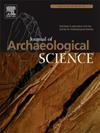反向磨粒机和旋转磨粒机磨粒时的能量消耗
IF 2.5
1区 地球科学
Q1 ANTHROPOLOGY
引用次数: 0
摘要
先前的实验考古学研究表明,在铁器时代,从互磨到旋转磨的转变为磨粉的妇女节省了75%的时间和每磨一定量的谷物的肌肉激活。然而,在时间和整体肌肉激活上检测到的组间差异是否反映了能量消耗的差异尚不清楚。在这里,我们使用间接量热法(氧气消耗和二氧化碳产生的分析)来测量在新石器时代的倒转壶和铁器时代的旋转壶上研磨的成年女性(n = 30)的能量消耗。我们的研究结果表明,旋转研磨每分钟需要高123 - 153%的能量消耗(每分钟研磨约2.7千卡),但研磨的净成本低42 - 49%,即,每给定数量的谷物的能量消耗(每公斤谷物约74千卡)与反向研磨相比。我们估计,从互惠制到旋转制的转变使妇女的日常生活费用减少了100-300千卡。本文章由计算机程序翻译,如有差异,请以英文原文为准。
Energy expenditure during grain grinding using reciprocal quern and rotary quern
Previous experimental archaeology studies have shown that the transition from reciprocal quern to rotary quern in the Iron Age saved grinding women 75 % of the time and muscle activation per amount of ground grain. However, whether the detected between-quern differences in time and overall muscle activation reflect differences in energy cost is unclear. Here, we used indirect calorimetry (analysis of oxygen consumption and carbon dioxide production) to measure the energy expenditure during grinding on a Neolithic reciprocal quern and an Iron Age bun-shaped rotary quern in adult females (n = 30). Our results revealed that rotary quern grinding required a 123–153 % higher energy expenditure per minute (by about 2.7 kcal per minute of grinding) but a 42–49 % lower net cost of grinding, i.e., energy expenditure per given amount of grain (by about 74 kcal per kilogram of grain) compared to reciprocal quern. We estimated that transitioning from reciprocal to rotary quern reduced women's daily subsistence costs by 100–300 kcal.
求助全文
通过发布文献求助,成功后即可免费获取论文全文。
去求助
来源期刊

Journal of Archaeological Science
地学-地球科学综合
CiteScore
6.10
自引率
7.10%
发文量
112
审稿时长
49 days
期刊介绍:
The Journal of Archaeological Science is aimed at archaeologists and scientists with particular interests in advancing the development and application of scientific techniques and methodologies to all areas of archaeology. This established monthly journal publishes focus articles, original research papers and major review articles, of wide archaeological significance. The journal provides an international forum for archaeologists and scientists from widely different scientific backgrounds who share a common interest in developing and applying scientific methods to inform major debates through improving the quality and reliability of scientific information derived from archaeological research.
 求助内容:
求助内容: 应助结果提醒方式:
应助结果提醒方式:


